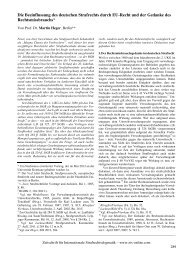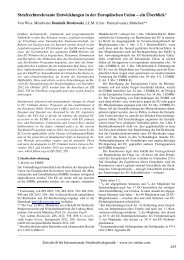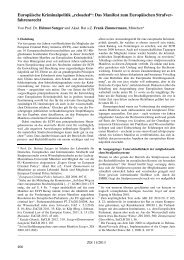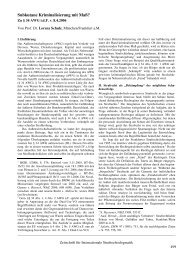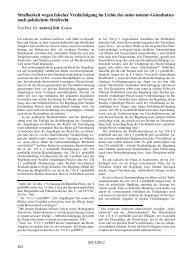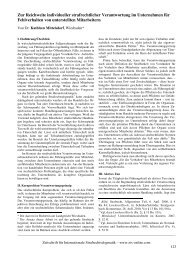Inhalt AUFSÄTZE ANHANG - ZIS
Inhalt AUFSÄTZE ANHANG - ZIS
Inhalt AUFSÄTZE ANHANG - ZIS
- No tags were found...
You also want an ePaper? Increase the reach of your titles
YUMPU automatically turns print PDFs into web optimized ePapers that Google loves.
Harmen van der Wilt_____________________________________________________________________________________tion and perpetration by means of another person overlap to alarge extent.In summary, we may conclude that functional perpetrationis a broader and arguably more flexible concept thanOrganisationsherrschaft, lacking the latter’s rigid and preciserequirements. This should come as no surprise, in view of theconcepts’ different social pedigrees. Whereas Organisationsherrschafthas been developed in order to identify individualresponsibilities within a delinquent state apparatus, engagedin system criminality, the Dutch concept of functional perpetrationhas emerged from the more ‘innocent’ cradle of economiccrime. Roxin has made an impressive effort to disentanglethe web of communications, command structures andfunctional responsibilities within a complex state bureaucracyof the Weberian type and has succeeded to translate thosesocial artifacts in normative terms of criminal law. 25 Functionalperpetration, on the other hand, has been the reactionof criminal legal doctrine in recognition of the fact that economicenterprising inherently entails risks for the environment,public health and consumers’ interests and increasesthe opportunities for offences which harm those very interests.By moving criminal responsibility upwards the hierarchyof the organization, functional perpetration instills themanagers and captains of industry that a proper course ofevents within the boundaries of law is within their power andcontrol and deters them from turning a blind eye to unlawfulconduct.In spite of these differences, the present author argues,first, that functional perpetration, when applied in the contextof system criminality, may serve useful purposes to identifythose who bear the greatest responsibility as well.26 And,second, that the concept, when employed in that specificcontext, bears surprising resemblance to the doctrine of Organisationsherrschaft.27 Let us shortly recapitulate the essentialsimilarities between the concepts.examine the composition of the milk. The accused was convictedas a perpetrator by means of another person, but theSupreme Court qualified the offense as ‘delivering full milk,if a substance has been added’: a perfect example of ‘functionalperpetration’ avant la lettre!25 Compare his perceptive comments on the Eichmann-case,in which he argues that Eichmann’s retort that the‘Endlösung’ would have been carried out anyway, even withouthis efforts, and that he had made a ‘senseless sacrifice’did not relieve him from individual responsibility; Roxin,Täterschaft und Tatherrschaft, 6 th ed. 1994, pp. 246-248.26 I have defended this position in a number of previous publications,see: Van der Wilt, Het kwaad in functie, (‘Evil infunction’) Inaugural address on the occasion of the acceptanceof the office of professor (‘Ordinarius’) at the Universityof Amsterdam, 2005, pp. 20-25; Id., ‘Joint Criminal Enterprise;Possibilities and Limitations’, Journal of InternationalCriminal Justice 5 (2007), 91 (102-107) and Id., in: Nollkaemper/vander Wilt, System Criminality in InternationalLaw, 2009, pp. 176-181.27 The connection between functional perpetration and Organisationsherrschafthas been recognized in:Both Organisationsherrschaft and functional perpetrationpresuppose and even require the existence of an organization.Although in the case of functional perpetration the organizationmainly serves to link up the physical with the indirectperpetrator and provides the context which facilitates andencourages the commission of crimes, nothing in the conceptprecludes a more active use of the organization as a tool tocommit crimes on a structural and permanent basis. Thesecond common ground which the concepts share is that theyboth require a hierarchically structured organization. Becausethe ‘man at the top’ exercises power and control over hissubordinates, he can be sure that his plans are executed.Again, in case of functional perpetration the power relationshipconnotes the possibility of intervention in order to stopemployees from indulging in crime. However, the political ormilitary leader can equally employ his power over othersmore actively, directing their wills and resources towards theaccomplishment of his intentions. The cases of the gynecologistand the farmer, delivering adulterated milk, provide examplesin kind.But the most conspicuous and fertile element is the ideathat function and crime are interwoven. Diversification offunctions and the abundance of specialized skills are of vitalimportance to modern state bureaucracies, also, and perhapsespecially, for those which engage in systemic crime. 28 Theindividuals may be dispensable, but the functions are certainlynot. In other words, the functionaries are pivotal to theworking and the success of the system. Each and every levelrequires specific skills and expertise. Obviously, the rank andfile should consist of physically strong and unfaltering personswho are not too much troubled by bad consciences. Atthe mid-level we find the typical Schreibtischtäter, punctualNoyon/Langemeyer/Remmelink (Ed.), Het Wetboek vanStrafrecht, losbladig commentaar, (The Penal Code: A looseleafcommentary), 2005, Part I, Note 19 at Article 47. Afterhaving considered that, in case of crimes against life or property,where the psycho-physical aspects are dominant, theapplication of modes of perpetration will probably survive,the authors add a remarkable caveat in a footnote: “As soonas we are dealing with the commission of such crimes in therealm of politics and crimes against humanity, however, theabstraction of ‘de facto’ action again increases. One mightrecall the term ‘Schreibtischmord’. In such cases, the loss of‘Tatnähe’ is compensated by the large power over the apparatus,which is at one’s disposal” (translation by the author).28 It is remarkable that the Peruvian Supreme Court has noticedthis crucial element in Organisationsherrschaft/ functionalperpetration. The passage deserves full quotation(§ 726): “Demzufolge ist ein wichtiges Merkmal dieser Formhierarchisch organisierter Strukturen, das zugleich ihre strikteVertikalität hervorhebt, die “Rollenzuweisung”. Dieser Ausdruckerweist sich als anschaulicher als jener der gegenwärtigenStrafrechtslehre, um das Verhältnis zwischen der strategischenEbene und dem Vollstrecker zu beschreiben; einVerhältnis, das auf eine Arbeitsteilung oder FunktionsverteilungBezug nimmt” (translation by Ambos/Huber, in thisissue; emphasis added)._____________________________________________________________________________________618<strong>ZIS</strong> 11/2009




